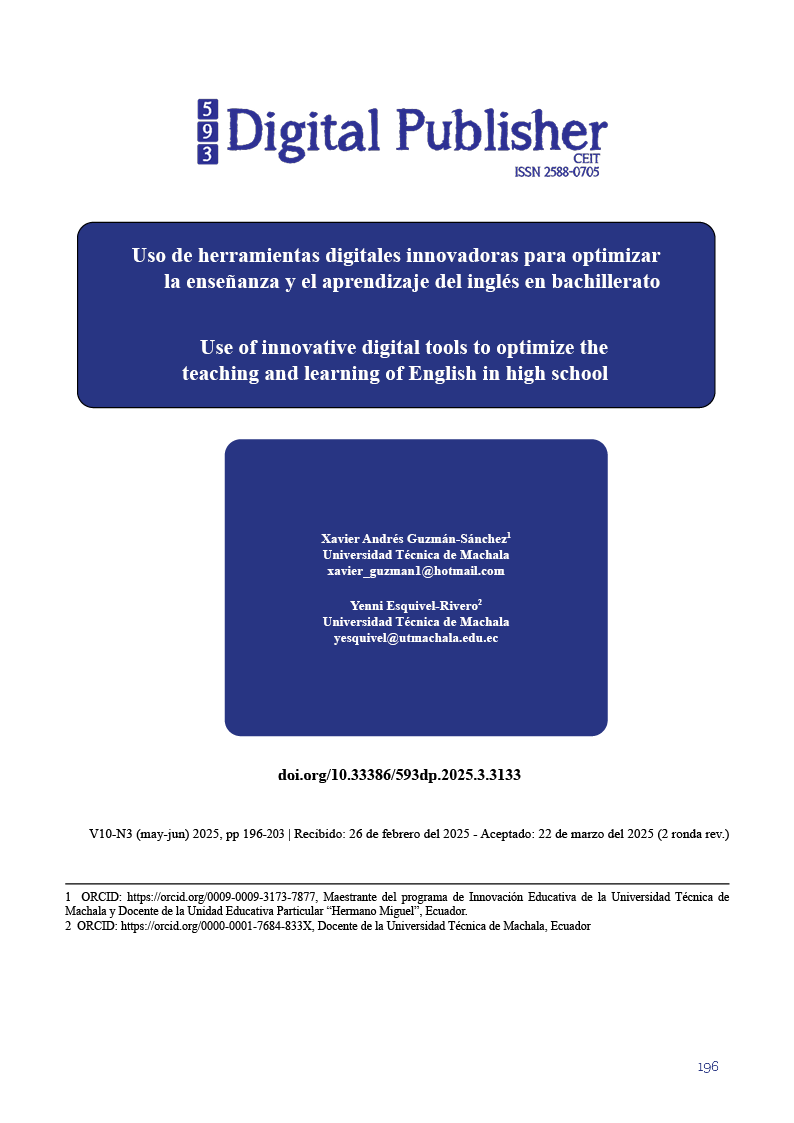Use of innovative digital tools to optimize the teaching and learning of English in high school
Main Article Content
Abstract
The present study examines the impact of innovative digital tools on the English teaching-learning process at the high school level. In this regard, the research focused on answering the following scientific question: How does using innovative digital tools influence the English teaching-learning process in high school students? Therefore, this research aimed to establish the impact of using innovative digital tools in the English teaching-learning process among high school students. The methodology employed a qualitative approach, conducting non-participatory observation in an educational institution in Machala city. The study evaluated the interaction between teachers and students on digital platforms used. The results show that while tools, such as Kahoot, Moodle, and Pear Deck can enhance motivation and academic performance, their implementation is limited and unstructured. It was identified that lack of teacher training, unequal access to technology, and sporadic use of these resources reduce their impact on learning. Additionally, it was observed that teachers mostly use basic digital tools, without leveraging advanced interactive strategies, which decreases students' interest in the long term. Although technology allows for personalized teaching and adaptation to different learning paces, methodologies that maximize this advantage are not applied. The research concludes that the effective integration of digital tools requires structured pedagogical planning, continuous teacher training, and equitable access to technology.
Downloads
Article Details

This work is licensed under a Creative Commons Attribution-NonCommercial-ShareAlike 4.0 International License.
1. Derechos de autor
Las obras que se publican en 593 Digital Publisher CEIT están sujetas a los siguientes términos:
1.1. 593 Digital Publisher CEIT, conserva los derechos patrimoniales (copyright) de las obras publicadas, favorece y permite la reutilización de las mismas bajo la licencia Licencia Creative Commons 4.0 de Reconocimiento-NoComercial-CompartirIgual 4.0, por lo cual se pueden copiar, usar, difundir, transmitir y exponer públicamente, siempre que:
1.1.a. Se cite la autoría y fuente original de su publicación (revista, editorial, URL).
1.1.b. No se usen para fines comerciales u onerosos.
1.1.c. Se mencione la existencia y especificaciones de esta licencia de uso.
References
Araujo bedoya, g. J., Guerra Delgada, l. R., Bastidas Santana, v. G., Diaz Berrúz, c. F., & Planta Ulloa, j. P. (2024). Educación y tecnología digital (1°). Cid - centro de investigación y desarrollo. https://doi.org/10.37811/cli_w1041
Bui, t. H. (2022). English teachers’ integration of digital technologies in the classroom. International Journal of Educational Research open, 3, 100204. https://doi.org/10.1016/j.ijedro.2022.100204
Cabero-Almenara, j., & Palacios-Rodríguez, a. (2021). La evaluación de la educación virtual: las e-actividades. RIED. Revista iberoamericana de educación a distancia, 24(2), 169–188.
García, e. K. G. (2024). Las plataformas digitales como recurso didáctico para reforzar el aprendizaje del inglés en educación primaria. Ciencia latina revista científica multidisciplinar, 8(1), article 1. https://doi.org/10.37811/cl_rcm.v8i1.9633
Guayasamín, k., & Inga, e. (2024). Aprendizaje invertido como herramienta educativa potenciadora para mejorar la lengua inglesa. Alteridad. Revista de educación, 19(1), 97–115.
López, v. R., Lara, s. D., López, r., & Caicedo, r. (2024). Vista de la analítica del aprendizaje aplicada a los recursos didácticos digitales en la enseñanza del idioma inglés. Dominio de las ciencias, 10(2), 1249–1273.
Manzaba, f. D. M., Laz, e. M. S. A., & Campuzano, m. F. P. (2021). Innovative digital tools in the teaching of the english language in high school. Palarch’s Journal of Archaeology of Egypt / Egyptology, 18(08), article 08.
Montalván, S. J. C., Santana, S. J. M., & Sera, R. M. (2023). Use of technological applications for teaching and learning english language during the pandemic. Uleam bahía magazine (ubm) e- ISSN 2600-6006, 4(7), article 7.
Quiñonez Pech, s. H. (2020). Competencia digital de los profesores de inglés en enseñanza primaria del sureste de México. Revista iberoamericana para la investigación y el desarrollo educativo, 11(21). https://doi.org/10.23913/ride.v11i21.752
Ramírez, p. F., Rodríguez, l. R., & Herrera, y. R. (2023). La enseñanza del inglés a través de las plataformas digitales en la universidad de artemisa, cuba | revista científica estelí. Revista científica estelí, 12(46), 165-183.
Ramírez-Elías, a., Arbesú-garcía, M. I., (2019). El objeto de conocimiento en la investigación cualitativa: un asunto epistemológico. Enfermería universitaria, 16(4), 424–435. https://doi.org/10.22201/eneo.23958421e.2019.4.735
Santamaría Urbieta, A. (2020). La herramienta digital Pear Deck y su uso en el aula virtual. Claves Para La Innovación Pedagógica Ante Los Nuevos Retos: Respuestas En La Vanguardia de La Práctica Educativa, 2020, ISBN 978-84-18348-22-8, Págs. 1546-1554, 1546–1554. https://dialnet.unirioja.es/servlet/articulo?codigo=7758269
Torres, M. R., Mera, p. V., Moscol, d. C., & Lemus, J. T. (2024). Estrategias pedagógicas y herramientas digitales en las clases en línea de inglés como lengua extranjera. Mejorando el proceso de enseñanza-aprendizaje. Revista invecom / issn en línea: 2739-0063, 4(1), article 1. https://doi.org/10.5281/zenodo.10525110
Yataco, P. V., Castro, m. Y. T., Valdivia, m. I. V., & López, G. S. L. (2023). Aprendizaje del idioma inglés a través de herramientas digitales en educación superior: revisión sistemática. Horizontes. Revista de investigación en ciencias de la educación, 7(27), article 27. https://doi.org/10.33996/revistahorizontes.v7i27.507
Valverde, J., Tobar-Sanchez, J. A., López-Fernandez, R., & Yeobanka Tapia-Bastidas, T. (2024). Implementación de herramientas didácticas digitales evaluadas por la analítica del aprendizaje en el proceso de enseñanza-aprendizaje del inglés. 593 Digital Publisher CEIT, 9(6), 103–114. https://doi.org/10.33386/593dp.2024.6.2658



